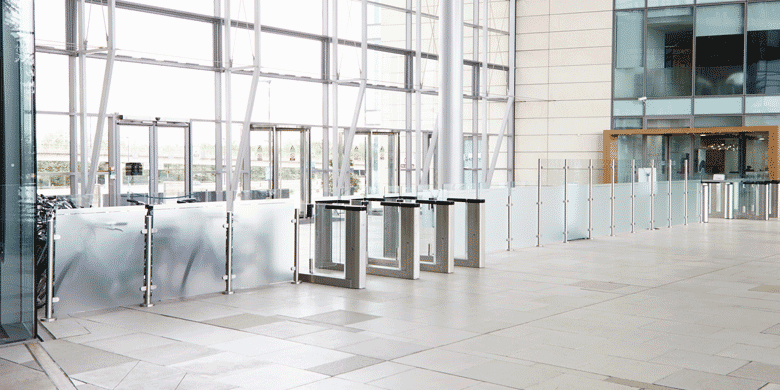
23 October, 2023
The Importance of Lanyards in Corporate Security
In corporate security, attention is often directed towards cybersecurity measures, access control systems, and surveillance technologies. However, one overlooked but essential aspect of security is the lanyard. Yes, you read that correctly: the humble lanyard plays a pivotal role in a corporate environment's overall safety and security. Lanyards are indispensable in securing access to office buildings and why they remain a preferred choice for ID badges.
Before diving into the technicalities, defining what a lanyard is is essential. A lanyard is a cord or strap worn around the neck, shoulder, or wrist to carry items such as ID cards, keys, or access passes. They are often made of durable materials like nylon or polyester and come equipped with various clips, hooks, and attachments to securely hold the card or object.
Key Factors for Using Lanyards in Corporate Security

When it comes to corporate security, "visibility" is a term that resonates on multiple levels. It is not just about installing high-end surveillance cameras or implementing advanced tracking systems. Sometimes, something as basic as the visibility of an employee’s identification can be a game-changer in bolstering security measures. Lanyards play a key role in achieving this visibility, providing an immediate and efficient method for identifying authorised personnel.
One of the principal advantages of a lanyard is that it hangs from the neck, placing it at roughly chest height for most individuals. This positioning ensures the ID badge is readily visible to anyone the wearer encounters. Unlike ID badges clipped to belts or tucked in pockets—which require a more focused effort to see—a lanyard places the identification front and centre, enabling quick visual confirmation of an individual’s status.
Standardisation is key in any security protocol, and lanyards help standardise the "sight-lines" for security personnel. When IDs are uniformly worn around the neck, security officers know exactly where to look to verify someone's identity. This accelerates the identity verification process, thereby making security checks more efficient.
They can come in various colours, and these colours can be strategically used to indicate different roles or access levels within the organisation. For example, a blue lanyard could signify an employee, while a red one could indicate a visitor, and a black one could be for executive staff. This colour-coded system further enhances visibility, allowing for rapid identification and sorting of individuals even from a distance.
When ID badges are highly visible, it becomes easier for security personnel to spot unauthorised individuals. If someone is not wearing a lanyard and ID, that alone can be an immediate red flag, prompting further investigation.
Their visibility reduces the likelihood of mistaken identity, which can have serious security implications. Security personnel are less likely to make errors in a system where identification is easily seen and verified.
In the case of an emergency, every second counts. The visibility of lanyards aids in swift decision-making. Security personnel can more easily identify employees, visitors, or even potential intruders, thus reducing response times in critical situations.
Convenience
Lanyards are not just beneficial for security personnel; they also offer convenience to the wearer. Most corporate settings require employees to swipe their ID cards multiple times throughout the day. Having the ID badge on a lanyard ensures quick and convenient access, reducing time spent searching for the card.
Reduced Loss Risk

When discussing corporate security, the concept of "loss prevention" usually brings to mind elaborate systems like CCTV cameras or anti-theft devices. However, one of the most straightforward yet effective loss-prevention tools is a lanyard. The risk of losing an ID badge, which is an essential component of corporate security, decreases markedly when a lanyard is used.
One of the main reasons why ID badges are less likely to be lost when attached to a lanyard is they remain constantly visible and accessible to the wearer. When you have your ID hanging around your neck or clipped to your clothing, you're constantly aware of its presence. Unlike an ID card stashed in a wallet or a pocket, which could easily be forgotten or misplaced, an ID on a lanyard is always within your field of vision and physical reach.
Most corporate environments have a rhythm and routine that employees follow. This often includes swiping an ID card to enter the premises, access specific floors, or even to use certain amenities like the cafeteria. When the ID badge hangs from a lanyard, it becomes integrated into this routine. The tactile experience of grabbing your ID from a lanyard to swipe it reinforces memory and habit, making it less likely that you'll walk away without it.
There's a psychological aspect to consider as well. The sensation of it around your neck or attached to your clothing constantly reminds you that it's there. This physical cue adds an extra layer of security by consistently reminding you of its presence, reducing the chances of forgetting it somewhere.
ID badges in pockets or wallets may be taken out at multiple points during the day—for meals, meetings, or comfort. Each removal is an opportunity for loss. However, when an ID is on a lanyard, the number of times it needs to be removed is generally reduced, as many access points are designed to read badges at chest height. Less handling means fewer opportunities for misplacement.
Technical Analysis

Material Selection
The type of material used for a lanyard can directly impact its effectiveness. Materials like woven polyester are durable and less likely to fray over time, maintaining the integrity of the ID badge and any embedded technology like RFID (Radio-Frequency Identification).
Attachment Mechanism
Different kinds of attachments can be used depending on the security needs. For high-security environments, ones with locking mechanisms or retractable reels offer added layers of security, ensuring the badge cannot be easily removed or stolen.
Saftey breakaway lanyards, which have a clasp that opens when pulled with force, are an essential safety feature in many corporate environments. This design ensures that the lanyard will break away if caught in machinery or grabbed by an assailant, reducing the risk of injury.
Modern ones often come with RFID technology embedded within the ID badge. This provides an additional layer of security, as the RFID chip can interact with access control systems to track and monitor movement within the building.
Though it may seem trivial, the cost of implementing lanyards should not be overlooked. High-quality ones with added security features may cost more upfront but can offer long-term benefits by reducing instances of security breaches, thereby potentially saving the company a significant amount in the long run.
Why Companies Prefer Lanyards
Ease of Implementation
Lanyards are easy to integrate into existing security protocols.
Cost-Effectiveness
Compared to more complex forms of identification, lanyards and ID badges are relatively inexpensive.
Flexibility
They can be customised to serve various functions, from simply holding an ID to integrating with complex access control systems.
Conclusion
They are far more than just pieces of fabric to display ID badges. They are an integral part of a comprehensive corporate security strategy. From enhancing visibility and standardisation to incorporating advanced safety features and technologies like RFID, they offer many benefits that cannot be ignored. As corporations continue to evolve their security measures, the humble lanyard will likely remain a staple in safeguarding both people and assets.
The Lanyards Only Team


